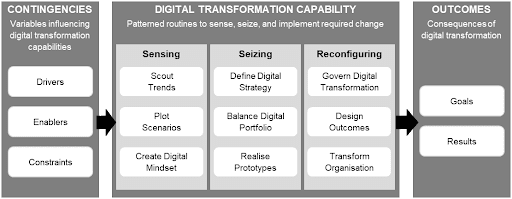To deliver transformations successfully, any organisation needs certain capabilities, and they are like trail running. Running up a mountain is hard work, and requires an adaptive approach: you need to listen to yourself and your environment, and you need to take time to rest in order to improve your time.
But more on this later, let’s first focus on digital transformation capabilities. Organisations need to sense the urgency for change, seize the opportunities, and transform themselves. This blog gives an overview of which capabilities are required to successfully deliver the digital transformation.
I have recently made the decision to move into academia and leave an exciting and interesting world of delivering transformations behind. One of my first research projects was focused on identifying what academia writes about when stating which capabilities are required to deliver a transformation successfully.
Digital Transformation Capabilities are defined as combining resources to produce value through delivering digital transformation where Digital Transformation definition is based on five S’s and is any change that:
- Source: implements the response to a volatile, uncertain, complex, and including digital technologies.
- Scale: delivers value by changing the business and operating models for the future.
- Scope: realises organisation-wide incremental and radical change.
- Speed: delivers accelerated change driven by digital technologies.
- Spell: is an ongoing and continuous activity.
What is a Digital Transformation Capability?
As part of my PhD research, I reviewed academic publications and developed a multi-dimensional framework of a digital transformation capability. I didn’t include the long version of 15,000 words, but if you are interested in a more detailed definition, please contact me. Various contingencies, which can be drivers, enablers, or constraints influence the digital transformation capabilities of sensing, seizing, and reconfiguring producing outcomes of goals and results.

Multi-Dimensional Digital Transformation Capability Framework
External drivers and internal drivers, enablers, and constraints
Digital transformations are often externally driven by digital technologies like analytics, machine learning, etc. but also by disruptive competitors. The enablers supporting successful digital transformation capabilities are internal to the organisation. Reaction to the VUCA environment (volatile, uncertain, complex, ambiguous), rate of change, and organisational legacy limit the application of dynamic capabilities for digital transformation. The drivers as external contingencies trigger the sensing capacity of the dynamic capability for digital transformation.

Digital Transformation Capabilities
For organisations to engage in digital transformation successfully, (dynamic) capabilities for digital transformation are required. Sensing capabilities scan the external environment for drivers of change to identify new risks and opportunities for the organisation. This includes scouting trends, plotting scenarios, and crafting a digital mindset. To exploit sensed opportunities and mitigate sensed risks, the organisation requires seizing capabilities. Defining the future strategy and design, balancing the digital portfolio, and prototyping a new design are key activities in seizing.
To execute on the sensed and seized opportunities and risks and to deliver the required change, the organisation requires reconfiguring capabilities. The organisation implements the governance of the digital transformation. The design encompasses the intended goals of the business model, the operating model, and culture and therefore includes value proposition, structure, process, technology, data, and behaviour. To transform the organisation and deliver the digital transformation, delivery methods and organisational change management are deployed. Organisational change management prepares and supports individuals, teams, and organisations in implementing the digital transformation and adopting outcomes. The process of transforming is continuous.

Outcomes of goals and results
The organisation is an open system and the event of successfully transforming an organisation is not pre-determined but dependent on the contingent conditions resulting in various outcomes. These outcomes are the consequences of digital transformation and are goals as target state, the what, and the results are purpose and value delivered. The fundamental outcome of a digital transformation is to create value. Organisations utilise different definitions to express value. Digital transformation results attempt to include enhanced stakeholder experience, superior operational performance, and increased market share.
Case study Dunnhumby
A few years ago, the data science company Dunnhumby used various digital transformation capabilities to extend its value creation. The demand for outstanding data science products in the retail space has been growing and Dunnhumby recognised the market opportunity to increase revenue while increasing profitability.
The sensing capabilities deployed included market and customer research to spot trends and requirements combined with a digital mindset that drove the definition of scenarios for the future. Enabled by digital technologies, Dunnhumby identified the product-led strategy as the right future direction, leading to the definition of a clear transformation portfolio and investment strategy showcasing its seizing capabilities. The transformation, i.e., reconfiguration and change of existing capabilities and building of new capabilities led to changes across Dunnhumby’s value propositions as part of its business model and related operating model changes.
The outcomes of its digital transformation were increased value creation for its stakeholders including shareholders, customers and employees.

Why building your transformation capability is like running up Snowdon?
Organisations use a combination of sourcing from or partnering with experts (like S&S) and building their own to get the required digital transformation capabilities. To ensure the capability is adequate and right, the organisation needs to look after the capability by exercising it and continuously improving and adapting it.
This is like my favourite sport fell running. You exercise your muscles through training runs, which also get you used to the challenge. You keep exercising and challenging yourself more, finding new routes, and trying different shoes, i.e., you adapt your capability to the situation and context you find yourself in. Building and maintaining the organisations’ digital transformation capability is the same. The organisation uses the capability of sensing, seizing, and reconfiguring constantly and reflects on how to improve it and adapt it to fit best the situation and context. This can include bringing external experts in or training your own colleagues on how to deliver the transformation.
Like in running, the digital transformation capability needs rest days to recover and improve. It’s important to take time to reflect on what went well and what can be improved, slow down and relax, and celebrate your successes.

Building your digital transformation capability is like running up Snowdon:
- Most transformations are hard work and continuously challenging, you cannot stop putting one foot in front of the other so keep going, even when things go wrong. Stop, reflect, and improve.
- It is a fantastic feeling of achievement when you stand at the top of Snowdon and deliver a part of your transformation together with your team – not only the process but also the result.
- Not only is the feeling at the top great, but the pint in the pub also afterwards tastes so much better. Take time to celebrate your successes and build your rest days into the plans.
- Don’t run up Snowdon every day, have rest and recover and reflect on how to improve the next time with a new route (do you need a new process of delivering), new shoes (do you need a new stakeholder management approach?) or different food (say ‘thank you’ more often?).
To conclude, digital transformations are in a continuous change of organisations’ strategic, business, and operating models enabled by digital technologies. Organisations need to understand the context they operate in and be able to exploit opportunities and mitigate risks by sensing those, forming a strategy and design with aligned investment, and transforming themselves.
If you want to understand more about the digital transformation capabilities framework, please reach out.





































































